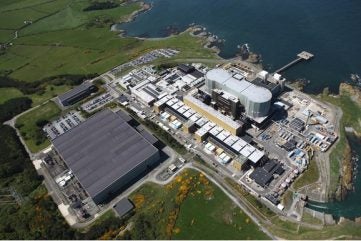
The UK government has selected Wylfa in Anglesey, North Wales, is its preferred site for a new NPP similar in scale to the one under construction at Hinkley Point C in Somerset. In March, Great British Nuclear (GBN) the arms-length body set up by the government to help deliver that extra capacity, acquired the Hitachi-owned sites for new nuclear at Wylfa and at Oldbury-on-Severn in southwest England for £160m ($203m). Both were considered as prospective sites for a new NPP but Wylfa has now been prioritised.
The government said it is exploring building a major nuclear power station, similar in scale to Hinkley in Somerset and Sizewell in Suffolk. Wylfa, on the North Wales coast, is ideally suited to host a plant “given its proximity to cooling water and nuclear heritage” the project “would revive the nuclear history of Wylfa and bring thousands of jobs and investment to the area, boosting the local economy”.
Wylfa has a long nuclear history. It hosted two 490 MWe Magnox reactors that began commercial operation in November 1971 and January 1972. Unit 2 was permanently shut in 2012 followed by unit 1 in 2015. Defuelling of the plant was completed in September 2019.
Meanwhile, Horizon Nuclear Power announced plans to develop a new nuclear reactor at the site in 2009, years before the original plant closed. The plan was to develop two UK Advanced Boiling Water Reactor units at Wylfa Newydd. In 2012, the Japanese company Hitachi offered to buy Horizon in a £700m deal spurring hopes that up to 6,000 jobs would be created during the construction phase, and 1,200 long-term jobs. However, in 2019 the plans faltered, with Hitachi citing spiralling costs. In 2020, the company withdrew its funding for the project entirely saying it had failed to reach a funding agreement with the UK government. A few months later Horizon Nuclear Power dropped its planning bid for the site.
The government says it is now kickstarting talks with global energy firms to explore building the new power plant, bringing the UK closer to its ambition for up to a quarter of its projected electricity needs to come from domestic nuclear power by 2050.
The government says the UK is delivering the biggest expansion to nuclear power in 70 years and suitable sites will be critical to meet ambitions to quadruple nuclear capacity by up to 24GW by 2050. This will come from a mix of traditional large-scale power plants and small modular reactors (SMRs), which can be rolled out more quickly and at scale.
Gwen Parry-Jones CEO of Great British Nuclear said: “Having agreed to purchase the Wylfa site earlier this year, GBN looks forward to working with the government on the market engagement programme for large scale gigawatt providers and also delivering this vital project in the years to come.”
Nuclear Industry Association CEO Tom Greatrex Chief Executive of the NIA said the government is “absolutely right” to pursue more large-scale nuclear alongside its SMR programme “Wylfa is an ideal place for a big nuclear project, and the community knows nuclear. We welcome the government’s engagement with potential partners internationally, and we urge them to move forward at pace. A large-scale project at Wylfa would be the single biggest inward investment in Welsh history, and a huge step towards both energy security and net zero for the whole country.”
The Welsh Secretary, David TC Davies, said he would not “put a date” on when a power plant could be built and ready for production, but added that Wylfa was “destined to have a nuclear power station”.
According to the Financial Times, Korea Electric Power Company (Kepco) has been in preliminary talks with ministers over the new Wylfa power plant. Bechtel and Westinghouse are also reported to have expressed interest.






